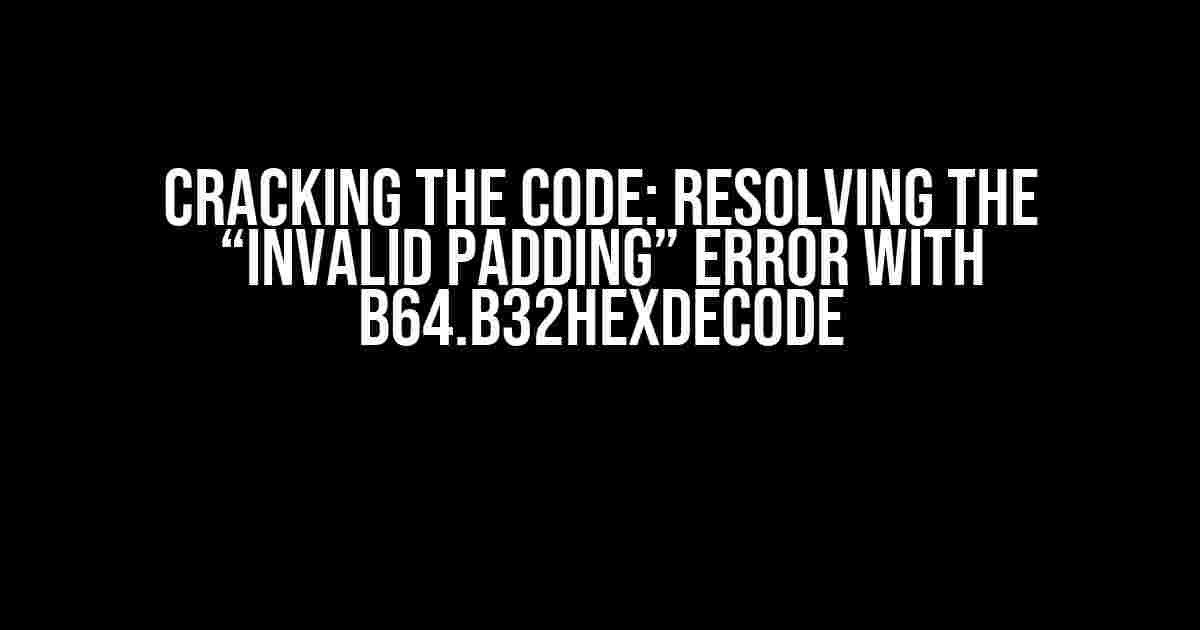Are you stuck with the frustrating “Invalid Padding” error when using the b64.b32hexdecode function in Python? Worry no more! In this comprehensive guide, we’ll delve into the world of base32 and base64 encoding, explore the common causes of this error, and provide step-by-step solutions to get you back on track.
Understanding Base32 and Base64 Encoding
Before we dive into the error, it’s essential to understand the basics of base32 and base64 encoding. Both are encoding schemes used to represent binary data in a text format, making it easier to transmit and store data.
Base64 encoding uses a set of 64 characters (A-Z, a-z, 0-9, +, and /) to represent data, while base32 encoding uses a set of 32 characters (A-V, 2-7). The primary difference between the two is the character set used and the resulting output length.
| Encoding Scheme | Character Set | Output Length |
|---|---|---|
| Base64 | A-Z, a-z, 0-9, +, / | Approximately 33% longer than original data |
| Base32 | A-V, 2-7 | Approximately 20% longer than original data |
The Culprit: “Invalid Padding” Error
The “Invalid Padding” error occurs when the decoder encounters an incorrect or missing padding character in the encoded string. This padding character is used to ensure the encoded data is a multiple of the encoding scheme’s block size.
In base32 encoding, the padding character is the “=” sign, while in base64 encoding, it’s the “=” sign followed by one or two additional “=” signs, depending on the encoded data length.
# Example of base32 encoded string with correct padding
SGVsbG8gd29ybGQhCg==
# Example of base64 encoded string with correct padding
SGVsbG8gd29ybGQhCgAAAAAAAA==
Common Causes of the “Invalid Padding” Error
The “Invalid Padding” error can occur due to several reasons, including:
- Incorrect or missing padding characters in the encoded string
- Truncated or corrupted encoded data
- Inconsistent encoding scheme usage (mixing base32 and base64)
- Incorrect decoding process or library usage
Resolving the “Invalid Padding” Error
To resolve the error, follow these step-by-step solutions:
Solution 1: Verify the Encoded String
Check the encoded string for correctness and completeness. Ensure the padding characters are present and correctly placed.
# Example of verifying the encoded string
encoded_string = "SGVsbG8gd29ybGQhCg=="
if not encoded_string.endswith("="):
print("Invalid padding detected!")
Solution 2: Use the Correct Decoding Function
Make sure you’re using the correct decoding function for the encoding scheme used. In Python, use the b64.b32hexdecode() function for base32 decoding and b64.b64decode() for base64 decoding.
import base64
# Example of base32 decoding
encoded_string = "SGVsbG8gd29ybGQhCg=="
decoded_data = base64.b32hexdecode(encoded_string)
# Example of base64 decoding
encoded_string = "SGVsbG8gd29ybGQhCgAAAAAAAA=="
decoded_data = base64.b64decode(encoded_string)
Solution 3: Handle Truncated or Corrupted Data
If the encoded data is truncated or corrupted, you may need to handle it manually. One approach is to strip the padding characters and decode the remaining data.
import base64
# Example of handling truncated data
encoded_string = "SGVsbG8gd29ybGQhC"
stripped_string = encoded_string.rstrip("=")
decoded_data = base64.b32hexdecode(stripped_string)
Solution 4: Use a Library with Built-in Error Handling
Consider using a library like pybase32 or base64url, which provide built-in error handling for padding issues.
import pybase32
# Example of using pybase32
encoded_string = "SGVsbG8gd29ybGQhCg=="
decoded_data = pybase32.b32hexdecode(encoded_string)
Conclusion
The “Invalid Padding” error when using b64.b32hexdecode() can be frustrating, but by understanding the underlying causes and applying the solutions outlined in this guide, you’ll be well-equipped to resolve the issue and get back to encoding and decoding like a pro!
Remember to verify the encoded string, use the correct decoding function, handle truncated or corrupted data, and consider using a library with built-in error handling. With these tips, you’ll be able to tackle even the most stubborn padding errors.
Frequently Asked Question
Are you stuck with the “Invalid Padding” error when using b64.b32hexdecode? Don’t worry, we’ve got you covered! Check out these frequently asked questions and answers to get back on track.
What is the “Invalid Padding” error when using b64.b32hexdecode?
The “Invalid Padding” error occurs when the input string is not a valid base32-encoded string, or when the padding is incorrect. This can happen when you’re trying to decode a string that’s not properly encoded or when the encoding process went awry.
How do I fix the “Invalid Padding” error when using b64.b32hexdecode?
To fix the error, make sure you’re providing a valid base32-encoded string as input. Check if the string is properly encoded and has the correct padding. You can also try removing any trailing or leading whitespace characters from the input string.
What is the correct padding for base32 encoding?
In base32 encoding, padding is represented by the ‘=’ character. The number of ‘=’ characters at the end of the encoded string indicates the number of bytes that are not used in the last group of 4 characters. For example, if the last group has only 1 byte, the encoded string will have 6 ‘=’ characters at the end.
Can I use b64.b32hexdecode to decode a string that’s not base32-encoded?
No, you cannot use b64.b32hexdecode to decode a string that’s not base32-encoded. This function is specifically designed to decode base32-encoded strings, and it will throw an error if the input string is not in the correct format. Use the appropriate decoding function for the type of encoding used in the input string.
How can I encode a string to base32 using Python?
You can use the base64 module in Python to encode a string to base32. Here’s an example: `import base64; encoded_string = base64.b32encode(b’my_string’).decode(‘ascii’)`. This will encode the string “my_string” to base32 and return the encoded string as a string.






